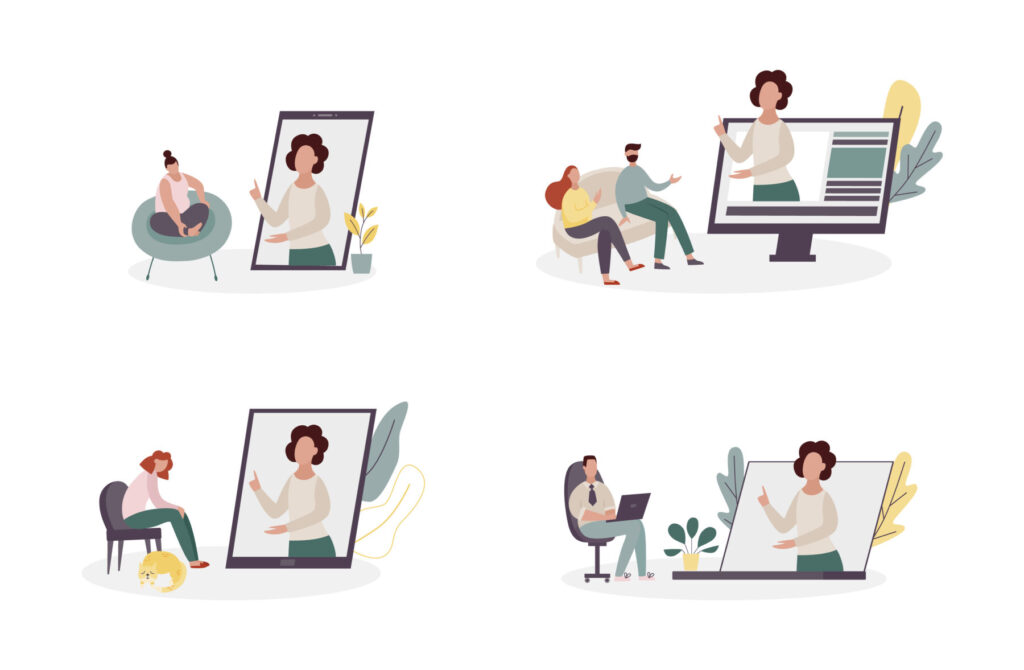How to Prepare for a Virtual Therapy or Teletherapy Session

In today’s fast-paced world, accessibility to mental health care has become more crucial than ever. The COVID-19 pandemic reshaped the way we approach healthcare, placing a spotlight on telemedicine, including online virtual therapy. In cities like Chicago, where life moves quickly and schedules are packed, the convenience of virtual therapy offers a lifeline to those seeking mental health support.
While virtual therapy was once a novel concept, it has now become a standard method for receiving mental health care. For many, the transition from in-person sessions to online therapy sessions brought concerns about privacy, connectivity, and building rapport through a screen. As a licensed therapist in private practice, I’ve guided many clients through this adjustment and want to share some key strategies to help you prepare for your online virtual therapy.
Why Prepare for Your Virtual Therapy Session?
Virtual therapy comes with many advantages: convenience, accessibility, and comfort from your chosen space. However, just as with in-person therapy, preparation is key to maximizing your experience. By getting ready for your online therapy sessions, you can focus on what matters most—your mental health.
How to Prepare: A Therapist’s Insight
Here, I’ll outline practical tips and strategies to ensure your online virtual therapy experience is productive and comfortable. Whether you’re a seasoned client or new to the concept of teletherapy, these steps will help you feel confident and prepared.
1. Choose the Right Environment
Set Up a Private, Quiet Space – While one of the perks of online virtual therapy is attending sessions from anywhere, it’s crucial to select a space that minimizes distractions and allows for privacy. Whether it’s your home office, a cozy corner in your living room, or even your parked car, make sure it’s a space where you feel safe and comfortable. Choosing the right (or wrong) time and place for your session can greatly impact its outcome. Consider who will be around and avoid spaces in which you don’t feel like you can talk freely about the topics that bring you to therapy in the first place.
Minimize Background Noise – Distractions can derail even the most engaging online therapy sessions. Use noise-canceling headphones to reduce environmental sounds, or place a white noise machine outside your room to create an auditory barrier. This can help maintain a sense of privacy and prevent others from overhearing your session (really important if you are talking about your relationship with a live-in partner!).
2. Test Your Equipment in Advance
Technical difficulties can be frustrating and disruptive. Before starting your online therapy session, make sure your equipment is functioning properly.
Check Your Internet Connection – A stable internet connection is essential for seamless communication. Try running a speed test ahead of time and close any unnecessary programs or tabs that could slow your bandwidth.
Ensure Your Camera and Microphone Work – Spend a few minutes testing your webcam and microphone to confirm they’re working. This simple step can save valuable session time and prevent initial awkwardness. Tandem Psychology uses a video-conferencing platform that allows users to test these functions in advance!
3. Prepare Mentally and Physically
Create a Comfortable Setting – One of the biggest advantages of online therapy sessions is that you can make yourself as comfortable as you wish. Grab a cup of tea, wrap yourself in a blanket, or settle into your favorite chair. Feeling physically at ease can help reduce anxiety and foster openness.
Have a Notebook Handy – It’s easy to forget what you want to discuss or ask during your session. Jot down your symptoms, recent changes in behavior, or any questions you have beforehand. Keep this notebook within reach during your session to take notes or write down insights shared by your therapist.
4. Minimize Distractions for Better Engagement
Put Your Phone Away – Even if your phone is out of the camera’s view, it can still be a source of distraction (as can Slack!). Place it on Do Not Disturb mode or turn it off completely to maintain focus on your session.
Close Unrelated Tabs – If you’re using a computer for your session, ensure that other tabs or apps are closed to avoid distraction. This will also help improve your internet connection and prevent interruptions. This is especially important if you are logging on during your work day!
5. Be Transparent with Your Therapist
Share Your Concerns – It’s natural to feel nervous or unsure about online therapy sessions. If you have concerns about privacy, comfort, or adjusting to this new method, share these with your therapist. Transparency is key to making teletherapy work for you. A 2021 survey by the American Psychological Association revealed that while 96% of therapists reported using telehealth during the pandemic and, most importantly, client comfort levels varied based on how well they communicated their needs and concerns. Talk to your therapist about the mode of service delivery–it’s part of the process too!
Address Nonverbal Cues – Body language can be harder to read in a virtual setting. If you notice your therapist making gestures or expressions that you’re unsure of, don’t hesitate to ask for clarification. This keeps communication clear and builds trust.
6. Stick to Your Schedule
Honor Your Appointment Time – Just like in-person therapy, online therapy sessions should be treated with the same level of commitment. Show up on time and be prepared to dive into your session. Setting calendar reminders or alarms can help you stay on track.
Troubleshoot Ahead of Time – Give yourself an extra 10-15 minutes before your session to troubleshoot potential Wi-Fi or tech issues. This way, you’re not scrambling at the last minute or eating into your session time.
During Your Virtual Therapy Session
Engage Actively – During your session, try to stay present and focused. It can be tempting to multitask, especially when at home, but dedicating this time solely to therapy ensures you get the most out of your experience.
Ask Questions and Clarify – Your first few virtual therapy sessions might feel different from traditional in-person therapy. Don’t be afraid to ask questions if something feels unclear. This can include your therapist’s techniques, their observations, or the goals for your treatment plan.
Commonly Asked Questions About Virtual Therapy
Q: Is virtual therapy as effective as in-person therapy?
Yes, studies have shown that online virtual therapy can be just as effective as traditional in-person therapy for many mental health conditions. The Journal of Affective Disorders published a 2022 study indicating that patients reported similar satisfaction and symptom improvement levels in both virtual and in-person therapy settings.
Q: What if I don’t have complete privacy?
As mentioned above, using noise-canceling headphones and a white noise machine can create a sense of privacy, even if others are in the house. Regardless, it is very important for you to feel that you have the level of privacy you need to be present during the session.
Q: How do I handle technical problems during my session?
Prepare by ensuring your equipment works properly before your session begins. If technical issues do arise, communicate with your therapist, who likely has backup plans or suggestions to continue the session effectively.
We’re here to help!
Virtual therapy is here to stay, and with good reason. It offers the flexibility to seek help from the comfort of your home, making mental health resources more accessible than ever. By following these tips, you can prepare yourself for an engaging and effective online therapy session that supports your mental health.
If you’re considering starting virtual therapy or want to know more about how online therapy sessions can benefit you, don’t hesitate to reach out to a licensed professional. Remember, taking the first step toward prioritizing your mental health is a courageous and valuable decision.
Prepare, engage, and make the most of your teletherapy journey—your future self will thank you.
This blog is made for informational and educational purposes only. It is not medical advice. The information in this blog is not intended to (1) replace a one-on-one relationship with a qualified licensed health care provider, (2) create or establish a provider-patient relationship, or (3) create a duty for us to follow up with you.



